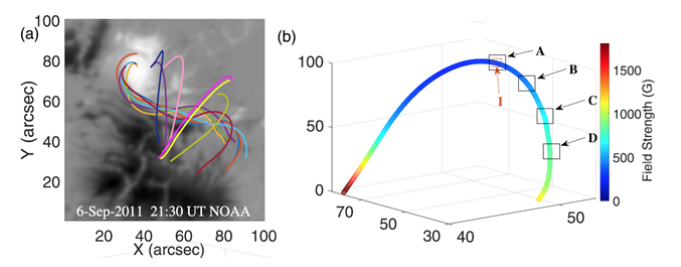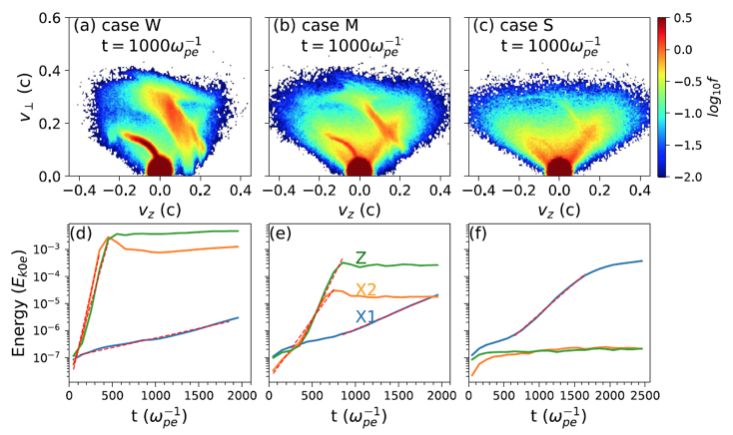Solar spikes are radio bursts closely associated with the impulsive stage of solar flares. They are characterized by extremely high brightness temperature of up to 1015 K, narrow-band, and short duration. Thousands of spikes could exist in an event. This leads researchers to suggest that solar spikes represent elementary energy release events during solar flares.
Earlier studies have suggested the electron-cyclotron-maser emission (ECME) driven by energetic electrons with the loss-cone distribution to be the emission mechanism of spikes (Holman et al. 1980). Yet, the loss-cone maser mainly excites the fundamental X mode (X1), and it is difficult for X1 to pass through the second harmonic absorption layer during its escape from the source (Melrose & Dulk 1982). This gives the so-called escaping difficulty of ECME when it is applied to solar radio spikes as well as other types of radio bursts associated with similar magnetic configurations.
Another problem is that most earlier studies employed prescribed analytical velocity distribution function (VDF) while any solar radio bursts are a consequence of a multiscale process starting from large-scale magnetic eruptive activities in the astronomical to MHD scale, followed by particle acceleration via magnetic reconnection or shocks in the particle kinetic scale and further excitation and propagation of electromagnetic radiations. In this study, as a starting point to bridge the large-scale dynamics and small-scale plasma kinetic maser instabilities associated with solar radio bursts, in particular, solar spikes, we developed a numerical scheme combining techniques including (1) the magnetic field extrapolation to describe the magnetic configuration of a normal loop within a well-studies active region (see Figure 1); (2) the guiding-center (GC) method to infer the temporal evolution of VDFs along various sections of the loop while taking the effect of pitch-angle scattering into account; and (3) the particle-in-cell (PIC) simulation to further explore the kinetic instabilities driven by electrons with the obtained VDFs. This represents a significantly simplified approach for the proposed study.

Figure 1 – (a) The magnetogram of HMI/SDO for AR 11283 before the eruption of the major X2.1 flare on 2011 September 6, overplotted with field lines given by the NLFFF extrapolation; (b) the selected loop structure for the GC simulation of energetic electrons. The color in panels (b) represents the field strength (in units of Gauss). The letters “A–D” represent the sections within which VDFs will be examined, and the letter “I” represents the region of injection.
It was found that the VDFs of energetic electrons injected from the loop top manifest interesting strip-like feature with significant positive velocity gradient, together with the familiar loss-cone feature (see upper panels of Figure 2). The strip-like features of VDFs are formed due to the bouncing motion of energetic electrons during the early stage of the VDF relaxation toward a well-developed loss-cone distribution. According to further PIC simulations fed by the corresponding VDFs in plasmas with the parameter setup of ωpe/ωce = 0.25, the strip-like feature is essential for efficient excitation of ECME at harmonic X mode (in the weak scattering case), while the loss-cone feature can be efficient in exciting the fundamental X mode (in the strong-scattering case). See Figure 2 for the PIC results.
Efficient amplification of X2 favors the escape of ECME radiation from the corona, and this effectively reduces the limitation of applying ECME to solar spikes. The study provides new insight into how escaping radiation, in particular, the harmonic X mode, can be generated within a coronal loop. The scenario presented here may also be useful to other types of radio bursts generated within similar astrophysical and space circumstances.
 Figure 2 – (a-c) VDFs at t = 1000 wpe-1 obtained by the PIC simulation for cases with various levels of scattering: W for weak, M for moderate, and S for strong scattering case; (d-f) temporal profiles of energies of various wave modes (X2, X1, and Z), normalized to the total energy of energetic electrons (Ek0).
Figure 2 – (a-c) VDFs at t = 1000 wpe-1 obtained by the PIC simulation for cases with various levels of scattering: W for weak, M for moderate, and S for strong scattering case; (d-f) temporal profiles of energies of various wave modes (X2, X1, and Z), normalized to the total energy of energetic electrons (Ek0).
This nugget is based on the paper by Yousefzadeh, M., Ning, H., & Chen, Y. 2021, APJ, 909 3 doi: 10.3847/1538-4357/abd8d5
References:
Holman, G. D., Eichler, D., & Kundu, M. R. 1980, in IAU Symp. 86, Radio Physics of the Sun, ed. M. R. Kundu & T. E. Gergely (Cambridge: Cambridge Univ. Press), 457
Melrose, D. B., & Dulk, G. A. 1982, ApJ, 259, 844
*Full list of Authors: Mehdi Yousefzadeh, Hao Ning, and Yao Chen
